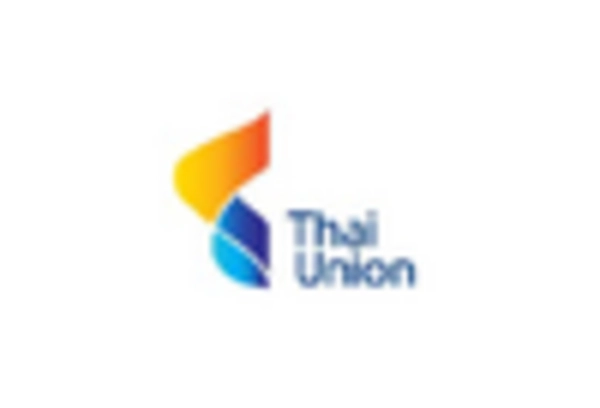Culinary Innovation
The Asian Food Market is currently experiencing a wave of culinary innovation, driven by the fusion of traditional recipes with modern cooking techniques. Chefs and food entrepreneurs are experimenting with flavors and ingredients, creating unique dishes that appeal to a diverse consumer base. This trend is particularly evident in urban areas, where food trucks and pop-up restaurants showcase inventive Asian cuisine. According to recent data, the market for Asian food products is projected to grow at a compound annual growth rate of 6.5% over the next five years, indicating a robust appetite for innovative culinary experiences. As consumers seek new and exciting flavors, the Asian Food Market is likely to benefit from this trend, attracting both adventurous eaters and those looking for authentic tastes.
E-commerce Expansion
The Asian Food Market is currently experiencing a significant expansion in e-commerce, as consumers increasingly turn to online platforms for their grocery shopping. This shift is driven by the convenience of online shopping and the growing availability of Asian food products through various digital channels. Recent statistics indicate that online sales of Asian food items have surged by 25% in the past year, reflecting a broader trend towards digital consumption. Retailers are investing in user-friendly websites and mobile applications to enhance the shopping experience, making it easier for consumers to access a wide range of Asian food products. This e-commerce growth not only provides consumers with greater convenience but also allows the Asian Food Market to reach a wider audience, including those in regions where traditional Asian grocery stores may be limited.
Health-Conscious Eating
The Asian Food Market is witnessing a significant shift towards health-conscious eating, as consumers increasingly prioritize nutrition and wellness in their food choices. This trend is reflected in the growing popularity of plant-based and low-calorie Asian dishes, which cater to the rising demand for healthier options. Data suggests that the market for healthy Asian food products is expected to expand by 8% annually, driven by the increasing awareness of health issues related to diet. Additionally, traditional Asian ingredients such as ginger, turmeric, and various vegetables are being highlighted for their health benefits, further appealing to health-conscious consumers. As the Asian Food Market adapts to these changing preferences, it is likely to see a surge in innovative products that align with the wellness movement, thereby attracting a broader audience.
Rising Demand for Authenticity
In the Asian Food Market, there is a notable increase in consumer demand for authentic culinary experiences. As globalization continues to influence food choices, consumers are becoming more discerning about the authenticity of the dishes they consume. This trend is particularly pronounced among millennials and Gen Z, who prioritize genuine flavors and traditional cooking methods. Market Research Future indicates that 70% of consumers are willing to pay a premium for authentic Asian food products, reflecting a shift towards quality over quantity. Restaurants and food brands are responding by sourcing ingredients directly from Asian regions and employing traditional cooking techniques, thereby enhancing the authenticity of their offerings. This focus on authenticity not only enriches the dining experience but also strengthens the Asian Food Market by fostering a deeper connection between consumers and the cultural heritage of the cuisine.
Cultural Exchange and Globalization
The Asian Food Market is significantly influenced by cultural exchange and globalization, which have facilitated the spread of Asian cuisine across various regions. As people travel and migrate, they bring their culinary traditions with them, leading to a greater appreciation for Asian food. This cultural exchange is evident in the increasing presence of Asian restaurants and food products in non-Asian countries, where consumers are eager to explore diverse flavors. Market data suggests that the demand for Asian food products has increased by 15% in regions previously less familiar with these cuisines. This trend not only enriches the culinary landscape but also enhances the Asian Food Market by creating new opportunities for growth and innovation. As cultural boundaries continue to blur, the Asian Food Market is poised to thrive in this interconnected world.


















Leave a Comment